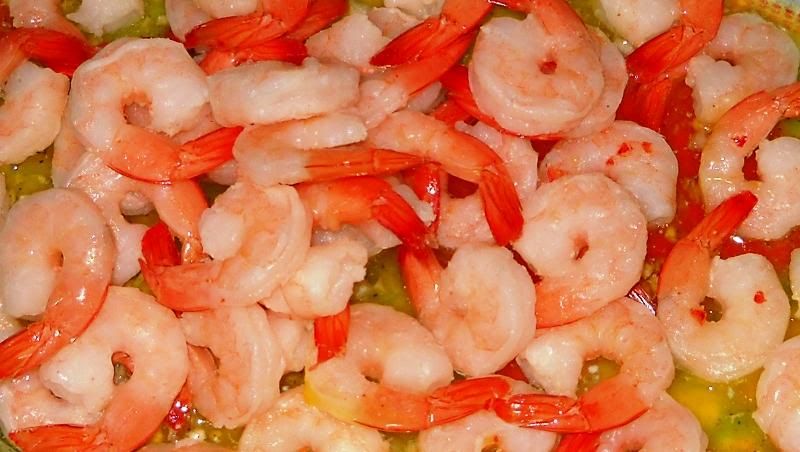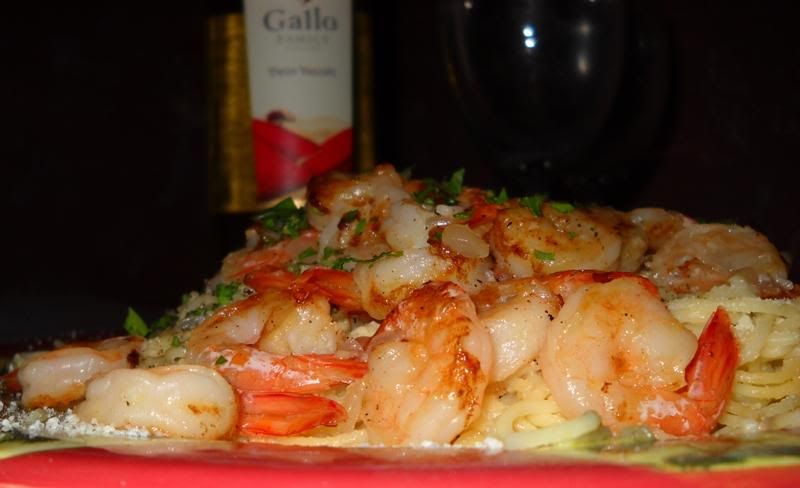Post by TasunkaWitko on Feb 10, 2011 18:48:03 GMT -5
This wonderful dish has is origins in Venezia (Venice), which lies in the Veneto region of north-eastern Italy. In reading Time/Life's Foods of the World - The Cooking of Italy (1968), I learned that Venice was literally built on food, and came across some dazzling accounts of the Grand Canal in Venice as well as a description of Veneto's place in Italian cuisine:
WikiPedia does a good job of explaining the term, "scampi:"
And Time/Life goes on to provide some elaboration:

Here is the recipe, provided by Time/Life:
And here is a direct link to my original post on Scampi alla Griglia, which includes a ton of historical research as well as many nice, step-by-step photos of the preparation:
foodsoftheworld.activeboards.net/shrimp-scampi-scampi-alla-griglia_topic846.html
Finally, here is a shot of this wonderful meal served on a bed of angel hair pasta:

If you try this, I hope you enjoy it!
[The modern] traveler steps through the station portals and lo - instead of a teeming, landlocked square, there are half a dozen wide steps stretching the whole length of the building and leading down into water. Along the bottom of the steps, the tall bows of gondolas bob up and down in the choppy wakes of motor boats. Before the eye lies the incredible spectacle of the Grand Canal, which Goethe called "the most beautiful street in the world." It leads to the culinary center of the city, the Piazza San Marco, which Napoleon, another traveler given to superlatives, characterized as the most elegant ballroom in Europe. On the canal, in the piazza itself and in the narrow streets behind the bell tower of St. Mark's basilica are some of the finest restaurants in Europe.
Almost all the buildings on the Grand Canal, except the churches and public edifices, are palaces. They remain the substantive evidence of the tremendous riches of Venice, reminders that this, in its medieval heyday, was the most brilliant, the most glittering, the most spectacular city in the world, the city that once "held the gorgeous East in fee." Its wealth and its palaces were built on trade monopolies in what were then rare foods: sugar, salt, pepper, spices, coffee. And the city that supplied these commodities to the rest of European world made lavish use of them at home, establishing a subtle and ingenious school of cooking - a finished cuisine enriched by the contributions from the lands brought under the control of Venice when her riches and power were at their height.
Of the three regions associated with Venice, only Veneto, where the city lies, has pure Italian cooking. The cooking of the Trentino-Alto Adige region, to the northwest, once owned by Austria-Hungary, is largely Austro-German. Still farther afield, Friuli-Venezia Giulia, which occupies part of the Dalmatian coast in the neighborhood of Trieste, offers overtones of Austrian, Hungarian, Slavic and Balkan cuisines on its menus. These influences are a natural consequence of the fact that Venice once controlled the entire Yugoslav coast and Trieste was once the Austro-Hungarian Empire's Adriatic seaport.
Almost all the buildings on the Grand Canal, except the churches and public edifices, are palaces. They remain the substantive evidence of the tremendous riches of Venice, reminders that this, in its medieval heyday, was the most brilliant, the most glittering, the most spectacular city in the world, the city that once "held the gorgeous East in fee." Its wealth and its palaces were built on trade monopolies in what were then rare foods: sugar, salt, pepper, spices, coffee. And the city that supplied these commodities to the rest of European world made lavish use of them at home, establishing a subtle and ingenious school of cooking - a finished cuisine enriched by the contributions from the lands brought under the control of Venice when her riches and power were at their height.
Of the three regions associated with Venice, only Veneto, where the city lies, has pure Italian cooking. The cooking of the Trentino-Alto Adige region, to the northwest, once owned by Austria-Hungary, is largely Austro-German. Still farther afield, Friuli-Venezia Giulia, which occupies part of the Dalmatian coast in the neighborhood of Trieste, offers overtones of Austrian, Hungarian, Slavic and Balkan cuisines on its menus. These influences are a natural consequence of the fact that Venice once controlled the entire Yugoslav coast and Trieste was once the Austro-Hungarian Empire's Adriatic seaport.
WikiPedia does a good job of explaining the term, "scampi:"
Scampi is a culinary name for some species of prawn, notably the 'true' scampi Nephrops norvegicus, and is also used as a name for a style of preparation of these lobsters and other seafood. In India, 'freshwater scampi' refers to the shrimp Macrobrachium rosenbergii....In Ireland, the United Kingdom and the USA, the word has come to define the method of preparation rather than the ingredient, although referring to quite different methods.
In the USA, "scampi" is often the menu name for shrimp in Italian-American cuisine (the actual word for "shrimp" in Italian is gambero or gamberetto, plural gamberi or gamberetti[3]). The term "scampi", by itself, is also the name of a dish of shrimp served in garlic butter and dry white wine, served either with bread, or over pasta or rice. The word "scampi" is often construed as that style of preparation rather than an ingredient, with that preparation being called "shrimp scampi", and with variants such as "chicken scampi".
In the UK and Ireland, "scampi" refers to the full flesh of a Norway lobster, deep fried in batter and breadcrumbs. "Whole tail" scampi is always made with Norway lobster, but other seafood such as monkfish tails may be used where this is not stated.
In the USA, "scampi" is often the menu name for shrimp in Italian-American cuisine (the actual word for "shrimp" in Italian is gambero or gamberetto, plural gamberi or gamberetti[3]). The term "scampi", by itself, is also the name of a dish of shrimp served in garlic butter and dry white wine, served either with bread, or over pasta or rice. The word "scampi" is often construed as that style of preparation rather than an ingredient, with that preparation being called "shrimp scampi", and with variants such as "chicken scampi".
In the UK and Ireland, "scampi" refers to the full flesh of a Norway lobster, deep fried in batter and breadcrumbs. "Whole tail" scampi is always made with Norway lobster, but other seafood such as monkfish tails may be used where this is not stated.
And Time/Life goes on to provide some elaboration:
Scampi are served in a seeming infinity of fashions: they can, for instance, be combined with other forms of seafood, in a brodetto, rolled in slices of ham, or boiled, cooled and served with a dressing of olive oil, lemon juice, salt and pepper. Scampi can be baked in the oven or fried, or - as I have grown to prefer them over the years - grilled in butter and garlic. The American cook need not be worried about not being able to buy genuine Venetian scampi: anything that can be done with them can also be done with [shrimp available in America].
Here is the recipe, provided by Time/Life:
Scampi alla Griglia
Broiled Shrimp with Garlic Butter
To serve 6:
2 lbs. large fresh shrimp in their shells or defrosted frozen shrimp
8 Tbsp. (1 quarter-pound stick) of butter
1/2 cup olive oil
1 Tbsp. lemon juice
1/4 cup finely-chopped shallots or scallions
1 Tbsp. finely-chopped garlic
1 tsp. salt
Freshly-ground black pepper
4 Tbsp. finely-chopped Italian flat-leaf parsley
Lemon quarters
Shell the shrimp, but be careful not to remove the last small segment of shell or the tail. With a small, sharp knife, slit each shrimp down the back and lift out the black or white intestinal vein. Wash the shrimp quickly under cold running water and pat them thoroughly dry with paper towels.
Preheat the broiler to its highest temperature. In a shallow flame-proof baking dish or pan just large enough to hold the shrimp in one layer, melt the butter over low heat, and be careful not to let it brown. Stir in the 1/2 cup of olive oil, lemon juice, shallots, garlic, salt and and a few grindings of pepper, add the shrimp and turn them in the butter and oil until they glisten on all sides. Broil them 3 to 4 inches from the heat for 5 minutes, then turn the shrimp over and broil them for 5 to 10 minites longer, or until they are lightly browned and firm to the touch. Be careful not to overcook them.
With tongs, transfer the shrimp to a heated serving platter, pour the sauce from the pan over them, and sprinkle with chopped parsley. Garnish with lemon quarters, and serve.
Broiled Shrimp with Garlic Butter
To serve 6:
2 lbs. large fresh shrimp in their shells or defrosted frozen shrimp
8 Tbsp. (1 quarter-pound stick) of butter
1/2 cup olive oil
1 Tbsp. lemon juice
1/4 cup finely-chopped shallots or scallions
1 Tbsp. finely-chopped garlic
1 tsp. salt
Freshly-ground black pepper
4 Tbsp. finely-chopped Italian flat-leaf parsley
Lemon quarters
Shell the shrimp, but be careful not to remove the last small segment of shell or the tail. With a small, sharp knife, slit each shrimp down the back and lift out the black or white intestinal vein. Wash the shrimp quickly under cold running water and pat them thoroughly dry with paper towels.
Preheat the broiler to its highest temperature. In a shallow flame-proof baking dish or pan just large enough to hold the shrimp in one layer, melt the butter over low heat, and be careful not to let it brown. Stir in the 1/2 cup of olive oil, lemon juice, shallots, garlic, salt and and a few grindings of pepper, add the shrimp and turn them in the butter and oil until they glisten on all sides. Broil them 3 to 4 inches from the heat for 5 minutes, then turn the shrimp over and broil them for 5 to 10 minites longer, or until they are lightly browned and firm to the touch. Be careful not to overcook them.
With tongs, transfer the shrimp to a heated serving platter, pour the sauce from the pan over them, and sprinkle with chopped parsley. Garnish with lemon quarters, and serve.
And here is a direct link to my original post on Scampi alla Griglia, which includes a ton of historical research as well as many nice, step-by-step photos of the preparation:
foodsoftheworld.activeboards.net/shrimp-scampi-scampi-alla-griglia_topic846.html
Finally, here is a shot of this wonderful meal served on a bed of angel hair pasta:
If you try this, I hope you enjoy it!





